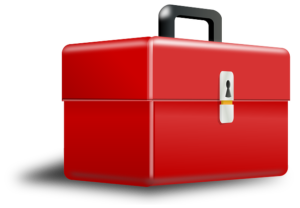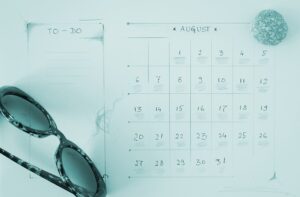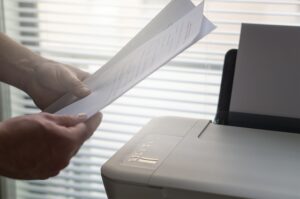by Jayme Radomski | Mar 10, 2020 | Bathroom, Clutter, Organizing
 Let’s be ruthless and get our overstuffed linen closets cleared out for real. We expect these little closets to hold too many items. To get the linen closet to a reasonable condition, lets look at the contents category by category. Empty out all the contents of this closet. Also, consider linen closet items that are not stored in the linen closet but fall into these categories. You might find these items in your bathroom, under your bed, in the kitchen, in the bedroom closet, and possibly in the car, garage, basement or attic. After we retrieve these items from around the house, sort them by category. Once we follow the guidelines below for each category, we can have fun organizing them back into the closet and labeling for continued organization.
Let’s be ruthless and get our overstuffed linen closets cleared out for real. We expect these little closets to hold too many items. To get the linen closet to a reasonable condition, lets look at the contents category by category. Empty out all the contents of this closet. Also, consider linen closet items that are not stored in the linen closet but fall into these categories. You might find these items in your bathroom, under your bed, in the kitchen, in the bedroom closet, and possibly in the car, garage, basement or attic. After we retrieve these items from around the house, sort them by category. Once we follow the guidelines below for each category, we can have fun organizing them back into the closet and labeling for continued organization.
At Top Shelf, we feel less is more and we like to keep only what we need. Here is a guideline of some typical items to consider.
- Paper Products
The linen closet is an ideal space to store extra paper products such as toilet paper and facial tissue. Keep a minimal amount of back up product in your bathroom due to limited space and the humid environment. Purchasing paper products in bulk can save money, but be aware of your storage space. You will want to avoid too much overflow into other areas of your home, unless you have ample overflow storage.
- Bath Towels
Keep two towels per person living in your house, and a couple fresh towels for guests. The extra towels can be donated to a local pet shelter.
- Hand Towels
Keep two or three hand towels per bathroom, or two hand towels per person living in your home. A couple fresh hand towels for guests is acceptable. Extra towels can be donated to a local pet shelter.
- Wash Clothes
Inventory your wash clothes and keep exactly what your family uses per week. Some people may use two wash clothes per day and others may only use a wash cloth on occasion. This category is very specific to your household. Consider donating extras to an animal shelter.
- Beach Towels
Beach towels are also unique to your household. The amount you need will depend on your lifestyle, how often you are at the beach, at the pool, on a boat or camping. You will need to figure out how many beach towels are reasonable to keep. If your kids spend their summer at camp with a swimming pool, you may want to consider a few extra towels in your inventory. If your family is more of a weekend warrior at the beach and lake, one towel per person is reasonable. These seasonal towels can be packed away and placed into storage during the winter, if they are not needed. Remember, you can always toss them in the wash when you get back from the lake or the pool so they are ready for the next day. Extra beach towels can also be donated to a local animal shelter.
- Medical Equipment
Medical equipment can take up a large section of real estate in a linen closet. Equipment only used seasonally or during an occasional illness may be stored in another location such as the basement or a larger closet. Equipment that is used regularly can remain in the linen closet as long as there is space.
- Medications
Medication’s should be gone through on a regular basis. When going through medications, gather all your medications in one location. Check the expiration dates of all medications. Also, consider medications that are not needed anymore. After the unneeded and expired are removed, you can sort the remaining into categories such as daily use, illness specific and kids’ medications. Local pharmacies and governments host collection days to safely dispose of medications.
- Toiletries and Personal Care Items
Toiletries and personal care items should be gathered and sorted. Remove the items that are expired, old and not used anymore. Place partially used products in the front of the closet to use them up first. Plan to use up your inventory of products before purchasing new items. Write down your inventory or take a photo to help resist the temptation to purchase these products before depleting what you have. These products tend to build-up, especially if you are into trying the newest products. Unopened, unexpired and unwanted products can be donated to local homeless shelters.
- Cosmetics
Before we dive into cosmetics, lets have a quick general discussion on the shelf life of them. In general, unopened cosmetics have a shelf life of two to three years. This depends on the product and where the product is stored. If a product is exposed to heat, light and humidity, even if unopened, the shelf life is reduced. A list of typical shelf lives of products is provided. However, the method of application will affect the life of the products. If you use your fingers and hands to apply products or do not keep applicators clean, the life is reduced due to the bacteria allowed to enter the product.
Application brushes: two to five years
Blush: one to two years
Eye shadow: one to two years
Eye liners and pencils: one to two years
Foundation: six to eighteen months
Lip products: one to two years
Mascara: three months
Skin care products: six months to one year
Sunscreen: one to two years
- Bed Sheets
The linen closet easily becomes a graveyard for old, unused bedding. These items should be cleared out of the closet, and grouped by set and size. Then, you can decide on what sets to keep and what sets to donate. Two sets per bed is a good rule of thumb. Keep an extra mattress protector for each size of bed, if you have young kids in the house. One set of bedding for the guest bed is plenty. If needed, you could pull a set from your regular bedding for the guest bed. Organize the sheets sets you plan to keep by bed size, and place them into a linen bag or in a labeled bin or basket.
- Non-Linen Closet Items
Any item that does not fall into the linen closet categories doesn’t need to be in the linen closet. Items often found in a linen closet include food, toys, games and clothing. These items could be placed in the kitchen or bedroom closets.
At Top Shelf, we love to see the freedom organizing a small space can bring to you and your household. Let us know how your linen closet project goes by posting photos at Top Shelf Home Organizing Facebook page. Need some guidance getting started, get in touch with Jayme.
by Jayme Radomski | Jan 8, 2020 | Clutter, Organizing, Saving Time

Setting Realistic Organizing Goals
In this new year and new decade, I want to share with you some simple ideas on how to set goals to be more organized in 2020. Being organized is a journey. To expect to become completely organized this month if you have not been organized in the past year or decade is unrealistic. Setting small weekly goals to get your home organized will be more manageable, leave you time to continue with your daily activities, and allow you to celebrate many small victories.
5 W’s of Goal Setting
Take some time to think about the benefits of being organized, and what that will look and feel like for you. Start a journal or notebook to track your progress, motivations, slowdowns and feelings. A good guideline for setting goals is to look at the five W’s.
- Why is it important for you to become and stay organized? How will this help you to be the best you?
- Where do you think you need the most organization? Is it an area of your home? Is it an area of your office? Would having more structure to your schedule be beneficial?
- When will you accomplish your goals? When will you make time to work on your goals? Set a realistic time frame to meet your goals. Getting organized is a journey, not a one-stop trip. Plan time in your days and your weeks to accomplish small goals.
- Who will be affected by being organized? Obviously you will directly benefit. Think about the other people who will positively benefit from organization and structure. Your boss will feel the benefits of your workspace being organized and your schedule more structured. Family members will see the benefits of an organized home and feel the benefits of you being less stressed. Relationships will flourish when this area of your life is under control.
- What do you want to organize? Look at the big picture and break it down into small steps and then into even smaller steps. If you want your entire home, office, storage unit, garage, attic and vacation home organized, you will need to set goals in each area. Furthermore, goals will need to be set for each room, and then even smaller goals will need to be set for each file, drawer, closet, box and bin. For example, if your goal is an organized bedroom, you will want to break your bedroom down into smaller categories. These smaller categories could include closet, dresser, under bed storage, bathroom and linen closet. Each of these areas can be broken down into very small projects that take just minutes. Your dresser can be separated into smaller categories such as undergarments, socks, pajamas, swimwear, t-shirts and accessories. A similar method can be applied to other areas.
Goal Setting Basics
- Specific
Be specific about your goals. Goals should be specific to what you really want and need to be organized. Go further than general statements like “I am going to get organized” and “I am going to organized my whole house.” Specific goals will go deep and detail areas of your home, and further into rooms, and then into drawers, closets, categories, boxes and bins.A calendar is a great way to break down your project into small specific goals. Each month you will have a large goal. The large goal can be broken down into smaller weekly goals, and then even further into very manageable daily goals. The smaller goals should be focused on achieving a larger goal to ensure a part of the project gets completed. If you are working on basement organizing, the smaller goals should lead you to accomplishing that larger goal.
- Measurable
You will want to have a way to measure your progress. Progress with getting organized can be a photo to visually remind you of what you have accomplished. It will help to know where you started and how far you have come. A simple check list or spreadsheet can also help you mark off your progress.
- Attainable
Set goals that you can achieve. Success meeting your goals will motivate you to keep going. Setting goals that will only take minutes a day will be more attainable than goals that take many hours out of your week. An attainable goal for you may be cleaning and organizing a refrigerator shelf, not the entire refrigerator. It will always feel better to move on to the next small goal when you have time than to set goals so large you cannot complete even one.
- Realistic
Be realistic about your time, lifestyle and goals. If your weekends are packed with running to activities and enjoying time with family and friends, you may only have a few minutes to work on your goals. Don’t plan to organize your entire office on Saturday if you have a full schedule. That will only lead to failure and frustration.
- Timely
Set timely organizing goals. Making progress will keep you motivated. If you plan for an organizing project to go on too long, you may lose focus. Planning your goals to be accomplished in a timely manner will help you and others see and learn that progress has happened and keep you going.
There are many monthly and daily organizing calendars available online. These can provide a great guide for you to plan your organizing journey. Top Shelf Home Organizing would love to help you on your journey. Jayme would be happy to help you set your organizing goals, and help you achieve your organizing goals.
by Jayme Radomski | Dec 6, 2019 | Clutter, Relationships, Holidays
 Year after year, you want to get all your holiday stuff organized completely. At the end of the holidays you are tired, life gets back to usual busyness and holiday items quickly get stashed away. Here are Top Shelf Home Organizing’s tips to get your holiday items organized and packed away properly. Organizing holiday items really is not different than organizing any other category of items in your life. Gather, sort, purge and store.
Year after year, you want to get all your holiday stuff organized completely. At the end of the holidays you are tired, life gets back to usual busyness and holiday items quickly get stashed away. Here are Top Shelf Home Organizing’s tips to get your holiday items organized and packed away properly. Organizing holiday items really is not different than organizing any other category of items in your life. Gather, sort, purge and store.
1. Gather
Retrieve all items from storage including the attic, basement and storage unit. Gather all items that were put on display this year. Unwrap, touch and hold each item.
2. Sort
Sort each piece into categories:
- Tree Décor
- Interior décor by room
- Exterior décor
- Holiday cards received
- Food storage
- Other
Within each of these categories, you will sub-sort items as:
- Used this year and will use again
- Used this year, but will not use again
- Did not use this year, but will use next year
- Did not use this year and I never want to use these (this includes defective lights and broken items)
- Do not use these and will not use next year, but they are family heirlooms, I must keep these items forever
3. Purge
Remove the items you have classified as “Did not use this year and I never want to use these,” and “Used this year, but will not use again.” These items can be donated, offered to friends and family or potentially recycled and disposed of.
4. Store
After the sort is done, plan for storage. Create ample space in one location to store holiday items. This is when you purchase storage containers and shelving if needed. Clear, small- to medium-sized containers that stack and nest well, work great for these delicate items. A shelf dedicated to holiday décor keeps these items organized and together. These items are readily available at most home goods stores immediately after the holidays.
Keep track of your categories created. Items should be stored and labeled in the same manner to keep next year’s decorating as simple and organized as possible. Holiday lights can be neatly wrapped individually for ease of install next year. Ornaments are carefully wrapped and stored. Carefully pack up the family heirlooms that you want to keep, but will not necessarily display often.
Top Shelf home Organizing loves to organize holiday décor. Contact Jayme to see how Top Shelf can help.
by Jayme Radomski | Jun 13, 2019 | Clutter
 Taking on an organizing project is a big task. I often get questions from friends and family on what products they need to purchase before beginning a project. You will want to be prepared with the correct supplies without buying the wrong supplies or too many supplies. Before you run out to the store to stock up, take a look at the supplies a Professional Organizer has on hand. The items are in order of importance so you can gauge what you should invest in.
Taking on an organizing project is a big task. I often get questions from friends and family on what products they need to purchase before beginning a project. You will want to be prepared with the correct supplies without buying the wrong supplies or too many supplies. Before you run out to the store to stock up, take a look at the supplies a Professional Organizer has on hand. The items are in order of importance so you can gauge what you should invest in.
- Permanent markers for labeling bags, boxes and bins.
- Large trash bags for removing trash and donations, and for storing large, soft, bulky items.
- Scissors for trimming, cutting, and opening packages and boxes.
- Packing tape for sealing boxes and bins.
- Zip close plastic bags of various sizes to contain small items.
- Label maker for printing neat, uniform labels that can be adhered to nearly every surface.
- Sticky notes work great for temporary labels on files, piles, bins and boxes.
- Work gloves for moving items around and protecting your hands.
- Bandages for nicks and scrapes on your hands and fingers.
- Rubber bands and Velcro for wrapping, separating and containing.
- File boxes with lids for sorting and storing files and other items. File boxes work great while organizing as they let you plan for purchasing bins.
- Tape measure helps you measure what will fit where, so you aren’t moving items multiple times to see what fits where.
- Multi tool kit for hanging, leveling and disassembling items.
- Scanner for retaining files and photos digitally to reduce papers and photos in your home and office. Preferably, a high capacity scanner than can handle many sheets per minute while scanning both sides of the document.
- Paper shredder for destroying personal files. Preferably, a high quality shredder that can handle many sheets at one time, and won’t get clogged up with an overlooked metal staple.
At Top Shelf Home Organizing, we love to help people get stuff done. See if Top Shelf Home Organizing can help you get your next organizing project started. Contact Jayme to schedule a consult or chat about organizing.
by Jayme Radomski | May 3, 2019 | Clutter, Productivity, Saving Time, Wardrobe
Preparing for a season transition can be stressful, especially if you have school aged children wrapping up their school year and end of year performances. While May is a busy month, I have created a list of things to do before summer is in full swing. The key to summer is to have a plan. 
- Budget
Summer days feel carefree and wide open. Your budget, however, may not be. Take some time to think about your summer budget. Summer time brings extra childcare and camp expenses. You may also be working a reduced schedule. Sticking to a budget can make your summer less stressful and more accomplished. No one wants to end the summer in debt and stressed out.
- Schedule
A change in schedule for the family will bring new challenges. Plan ahead for summer activities and childcare. For you, schedule time for self care and exercise. If you are good about getting to the gym during the school year, you will want to schedule similar exercise time in the summer. It’s easy to put other family member’s schedules before yours in the summer. Your local library and school are great resources for scheduling activities for your children.
- Travel
Its time to plan your travel routes and lodging for summer travel. Choose your destination, and schedule and research the best flights, routes and lodging. If you have your travel plans nailed down, its time to get into the details. Research the best local cuisine, fun day excursions, the best parks in the area, and free things to do with kids. It is also a good idea to gather all important travel documents, and know where the local medical clinics are and drug stores for necessities while traveling. For the weekends you are local, research your city’s summer bucket list for fun local explorations.
- Lazy Days
Plan plenty of lazy days for you and your family. Allow yourself some time to read a book, nap in the hammock or putts in the garden. Kids love exploring in the backyard, creating fairy gardens, collecting bugs and camping in the backyard. These creative activities are tough to accomplish with an overscheduled summer.
- Self Care
Do a few things for yourself in advance of summer time. Schedule a hair appointment for a fresh cut and color. Pay attention to your feet by starting the sandal season with a fresh pedicure. Stock up on sunscreen for both your body and your face. Declutter your makeup, toss the old items and add a fresh lip color to your collection. This is also a great time to clean out your medicine cabinet. Dispose of expired or unneeded medications, and ensure your first aid kit is stocked.
- Your Wardrobe
If you have not yet transitioned your wardrobe, do it now. Purge the fall, winter and spring items that don’t suit you, instead of packing them away. If you didn’t like them this year, you won’t like them next year (even if you lose the ten pounds you are working on). For your summer wardrobe, get all items from storage. Carefully select the items you want to wear, purge the rest. Make a list of items you need to complete your wardrobe and carefully purchase only those items.
- Kids Wardrobe
This purge is very similar to what you would do for your own wardrobe. The good news is that it is easier to work through someone else’s clothes than your own. Remove the fall, winter and spring items that are worn, stained and will not fit your children next year. If you are saving clothing for a younger child, only save the items that you truly love and are in good condition. There is no reason to handle stained or worn clothes more than one time. Neatly pack away the clothes you are saving. Make sure they are clean and neatly folded, and placed in clear plastic bins that are labeled so you know right where to find them. Make a list of the items your children need for the summer season, so you can once again shop with meaning. Keep in mind summer camp and extended trips when inventorying kids clothes.
- Purge Toys
With the kids spending more time outdoors, it is a great time to get into the playroom and basement, and purge the toys they don’t receive joy from. Consider the plastic toy sets they received for their birthday that are now missing parts and have broken pieces, the toys they scatter around unproductively, the nostalgic toy your mother-in-law picked up at a rummage sale last summer, and the toys they have simply outgrown. Keep the basic toys that allow for creative play such as Legos, Magna tiles, dolls and a few Nerf guns.
- House
Prepare your house for a fresh start to the summer. Taking care of a few things inside and out gives you a neat and clean feel for the summer. Inside the house a good deep clean and purge will free up some space. Clean the windows for a clear view, and clean the oven now that roasting season is over. Have your air conditioning system inspected and serviced. Moving to the outside, give your grill a good scrub down. You’ll be amazed how great a clean grill can feel. Wash down patio furniture and the cushions for meals on the porch. Tackle the weeds in the garden now while the soil is moist and soft, and weeds are small. Apply a pre-emergent to your gardens as well to prevent new weeds from appearing. Seed the areas of your lawn that are thin. Add some fresh annual flowers to the front flower beds for some curb appeal. Clean the walkway, driveway and garage floor. Prepare your lawn mower by servicing the engine and sharpening the blades. Inflate the bicycle tires and grease the chains for summer bike rides.
At Top Shelf Home Organizing, we love to help people get stuff done. See if Top Shelf Home Organizing can help you get ready for summer. Contact Jayme to schedule a consult or chat about organizing.
by Jayme Radomski | Apr 3, 2019 | Clutter, Money & Paper Management
 Whether you own a business, run an office, are an entrepreneur or manage a household, going paperless can reduce clutter and improve efficiency. Although it is nearly impossible to go completely ‘paperless’, you can benefit greatly by digitizing much of your paperwork. This will reduce the amount of physical paper you keep.
Whether you own a business, run an office, are an entrepreneur or manage a household, going paperless can reduce clutter and improve efficiency. Although it is nearly impossible to go completely ‘paperless’, you can benefit greatly by digitizing much of your paperwork. This will reduce the amount of physical paper you keep.
Benefits to reducing physical papers include increasing productivity, reducing time spent on paper management, and having a system that is easily accessible to you and your team. This article focuses on creating a system of digital document workflow.
Document Workflow
Having a basic document workflow is the first step in properly establishing a reduction in papers. This simple workflow is described below.
Reception-Inbox-Capture-File
Reception
Reception includes receiving of both physical and electronic documents. Reduce the number of documents that enter your office by unsubscribing to emails and physical subscriptions. Eliminating the unnecessary saves time from having to manage useless papers. Recycle unnecessary physical documents and unneeded emails immediately. The remaining documents move to or stay in the Inbox.
Inbox
Have an inbox where documents are placed when they come in. This is where the documents reside until they are addressed. You should have a physical inbox and an email inbox for each person involved.
Once the document is addressed (read, paid, acted on, forwarded), it will be captured and moved the place it will be stored. How and when you move documents to file is up to you. You can save them for a limited period of time (day, week, month) and then have the documents filed.
Capture
Capture the information from the documents. Physical papers are scanned to electronic files, typically to a PDF (portable document file). Emails and electronic documents are also converted to PDFs. I find it helpful to go through and scan/create PDFs in small batches before filing. Letting the pile get too large can get overwhelming. This can also cause confusion if there are documents that need to be retrieved, but have not yet been filed properly.
How to Capture Documents
You can capture documents in many different ways. A mobile device or a document scanner work well for this.
Document scanners work great for processing larger quantities of documents, and converting them to PDF files and searchable PDF files. Consider a scanner that can handle many documents at one time, and has the capability to capture both sides of a two-sided document. Neat and ScanSnap are couple tools that work great for this. You can also outsource your scanning if you have a large number of documents and are short on time. Using a multi-function printer-copier-scanner can prove to be frustratingly slow, as it may allow only one side of a document to be scanned at a time.
From your phone or tablet, you can capture business cards, receipts, track mileage, and have documents signed on-site. There are also apps that can scan a business card and add the information right to your contacts and connect you on LinkedIn. I discuss a few of these resources below.
CamCard is great for capturing, saving and exchanging business cards
Evernote is great for managing all types of digital papers
MileBug mileage tracker app uses phone GPS and can export mileage to Excel
Expensify captures receipts and forms expense reports
Shoeboxed captures and manages receipts and mileage
Quickbooks is a full service accounting software that can invoice, track receipts, manage payroll and prepare financial reports
DocuSign and HelloSign allow you to receive full legal signatures from your mobile device and send them to email or your cloud-based storage
File
To effectively create useable file system, the file structure and naming convention of each file needs to be consistent and easy to follow. Create a file structure and naming convention that makes sense to you.
File Structure
You will create an electronic file folder structure similar to a physical file cabinet. Think about how you will search for the file when you need to reference the document. Keep the file structure simple. Don’t have too many layers of folders that could over complicate things, or be too challenging to use. You will want to keep the file folders simple and shallow. For example, Insurance folder can store home owner’s insurance and automobile insurance. The way you name the file will expose more details to the content of the documents.
File Naming Convention
Create a consistent file naming convention (how you label your files) that is easy to follow, and coordinates with how you would look for the file. If you work with a team, have the team decide together on the best naming convention. That way it makes sense to everyone and everyone is willing to use the consistent naming convention.
It is good to include the date, subject or file folder title, client name, client code or number, and other words to help you recognize the contents of the document. I like to start with the date so the files are nicely organized by date first. The subject or file folder name would come second. Remember, they will be placed in a folder that contains the main subject.
For example, in a “Contractor” folder you might have a file titled like:
“04012019 Contractor Top Shelf Invoice.pdf “. This could be your April invoice from Top Shelf Home organizing that you received on April 12, 2019.
In your “Insurance” folder you might have a file titled similarly to:
“01012019 Insurance Automobile Jan thru April.pdf” This could be your automobile insurance for the first half of 2019 that was effective January 1, 2019.
Where to Store Files
There are a few places you can store your documents; the cloud, your computer, external hard drive and automatic backup service. Select at least two locations such as your computer and the cloud, so when the inevitable happens your files are backed up. Remember fires, floods and theft, and consider an off-site back up method.
Cloud storage examples include Dropbox, Evernote, and Google Drive.
Computer storage includes Windows folders, Finder on Mac OS. There are also additional software products available for purchase that can streamline your files.
External hard drives are available for backing up your files. These drives are capable of storing very large files and lots of them for a reasonable price. You can also back your files up on simpler external ‘jump’ drives, which are more portable for storing backed up data offsite.
When implementing your file system, start with current documents. Get your system in place and bugs worked out. Once your system is up and running, begin to work through our backlog. It will go much quicker than you think.
Start your paperless journey with a plan. Jumping in without a good structure in place will lead to frustration and likely failure. The team at Top Shelf is happy to help you create your plan and guide you through the process. Get in touch with Jayme when you are ready to take the next step.
 Let’s be ruthless and get our overstuffed linen closets cleared out for real. We expect these little closets to hold too many items. To get the linen closet to a reasonable condition, lets look at the contents category by category. Empty out all the contents of this closet. Also, consider linen closet items that are not stored in the linen closet but fall into these categories. You might find these items in your bathroom, under your bed, in the kitchen, in the bedroom closet, and possibly in the car, garage, basement or attic. After we retrieve these items from around the house, sort them by category. Once we follow the guidelines below for each category, we can have fun organizing them back into the closet and labeling for continued organization.
Let’s be ruthless and get our overstuffed linen closets cleared out for real. We expect these little closets to hold too many items. To get the linen closet to a reasonable condition, lets look at the contents category by category. Empty out all the contents of this closet. Also, consider linen closet items that are not stored in the linen closet but fall into these categories. You might find these items in your bathroom, under your bed, in the kitchen, in the bedroom closet, and possibly in the car, garage, basement or attic. After we retrieve these items from around the house, sort them by category. Once we follow the guidelines below for each category, we can have fun organizing them back into the closet and labeling for continued organization.




